| Nicholson Cemetery | |
|---|---|
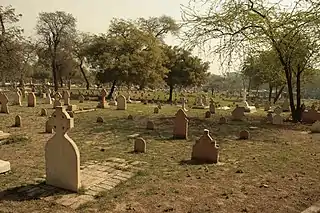 Nicholson Cemetery | |
| Details | |
| Established | 1857 |
| Location | Delhi |
| Country | India |
| Coordinates | 28°40′09″N 77°13′31″E / 28.66919°N 77.22519°E |
| Type | Christian |
| Owned by | St. James Church |
Nicholson Cemetery, formerly known as the Old Delhi Military Cemetery and the Kashmere Gate Cemetery, is a Christian cemetery located in Kashmere Gate, Delhi, India. It is located near the Kashmere Gate Metro Station and west of the Inter State Bus Terminal. It is the site of the earliest known Christian burials in Delhi NCR. The cemetery was established in 1857 and is named after Brigadier-General John Nicholson, a Victorian era military officer who played a pivotal role during the Indian Rebellion of 1857. The St. James' Church, who owns the cemetery, is the oldest place of worship for the Christian community of Delhi. The church along with cemetery, St. Stephen's hostel, and the Victorian era houses of Kashmere Gate neighbourhood were once considered to be a "centripetal" part of Christians in Delhi.[1]
According to the Indian Paranormal Society the headless apparition of John Nicholson haunts the place.[2] There are also other speculations that the ghosts of Europeans haunt the place.[3]
History
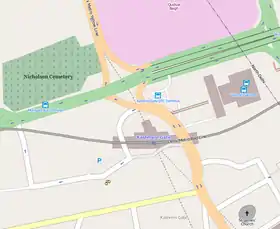
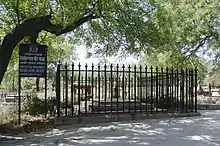
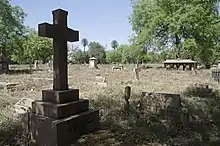
Nicholson Cemetery is located in Kashmere Gate near metro station and west of Inter State Bus Terminal.[4][5] Established in 1857, Nicholson Cemetery is the oldest Christian cemetery in Delhi NCR. It was known as the Old Delhi Military Cemetery or Kashmere Gate Cemetery until the early 1900s, when it was named after John Nicholson, a brigadier-general in the British Army.[6][7]
John Nicholson was born on 11 December 1821 in Dublin, Ireland. His father, Alexander Nicholson, was a physician. The Nicholson family moved to Lisburn, after the demise of Alexander in 1830. Nicholson was afterwards sent to the college at Dungannon. His maternal uncle, Sir James Weir Hogg, obtained a cadetship for him in the Bengal Infantry. He joined for duty at Banaras, and was attached to the 41st native infantry. In December 1839, he was posted to the 27th native infantry at Firozpur. He served in the First Anglo-Afghan War (1839–1842) and First Anglo-Sikh War (1845-1846), but he was best known for his pivotal role in the Indian Mutiny of 1857 especially during the Siege of Delhi.[8]
The Indian Rebellion of 1857 began as a mutiny of sepoys of the East India Company's army on 10 May 1857, in the town of Meerut, and soon escalated into other mutinies and civilian rebellions largely in the upper Gangetic plain and central India, with the major hostilities confined to present-day Uttar Pradesh, Bihar, northern Madhya Pradesh, and the Delhi region.[9] Nicholson was deputy-commissioner at Peshawar during that time. He played an instrumental role during the Siege of Delhi, one of the decisive conflicts of the rebellion. The assault of Delhi took place on 14 September 1857, and Nicholson was selected to command the main storming party. He was shot in chest by a sepoy of rebellions. He was carried to a hospital tent, but after lingering a few days he died of his wounds on 23 September.[8]
The number of casualties resulted from the Siege of Delhi created the rising demand for a Christian cemetery in the area. A new burial-ground was opened in front of the Kashmere Gate, near to Ludlow Castle. Nicholson was among the first people who were buried there. A white marble slab from the Red Fort was taken to build his tombstone and epitaph on it reads:[7][10]
The grave of Brigadier General John Nicholson who led the assault of Delhi but fell in the hour of victory mortally wounded and died 23rd September 1857 aged 35
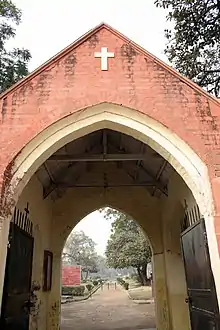
Renovation
The British High Commission in India renovated the cemetery in 2006. It hired British multinational security services company G4S (formerly Group 4 Securicor) to provide security.[11]
Notable graves
See also
References
- ↑ G. Dastidar, Avishek (24 December 2007). "Church rings in chimes of change". The Hindustan Times. New Delhi. Archived from the original on 17 November 2018. Retrieved 3 November 2012.
- ↑ "Capital's tourist trail gets a spooky twist". The Hindustan Times. New Delhi. 10 September 2012. Archived from the original on 10 April 2016. Retrieved 3 November 2012.
- ↑ Vivian Smith, Ronald (11 September 2009). "Creatures of the night". India Today. Retrieved 3 November 2012.
- ↑ Smith, Ronald Vivian (2005). The Delhi that no-one knows. New Delhi: Orient Blackswan. p. 119. ISBN 8180280209.
- ↑ "Veteran cartoonist T. Samuel passes away". The Hindu. Press Trust of India. 3 November 2012. Retrieved 5 November 2012.
- ↑ Harvey, David Charles (1999). Monuments to Courage: Victoria Cross Monuments and Headstones. Vol. 1. Kevin & Kay Patience. p. 82. OCLC 59437297.
- 1 2 Llewellyn-Jones, Rosie (2007). The Great Uprising in India, 1857-58: Untold Stories, Indian and British. Woodbridge: Boydell & Brewer. p. 188. ISBN 978-1843833048.
- 1 2
 One or more of the preceding sentences incorporates text from a publication now in the public domain: "Nicholson, John (1821-1857)". Dictionary of National Biography. London: Smith, Elder & Co. 1885–1900.
One or more of the preceding sentences incorporates text from a publication now in the public domain: "Nicholson, John (1821-1857)". Dictionary of National Biography. London: Smith, Elder & Co. 1885–1900. - ↑ Bandyopadhyay 2004, pp. 169–172 Bose & Jalal 2003, pp. 88–103 Quote: "The 1857 rebellion was by and large confined to northern Indian Gangetic Plain and central India.", Brown 1994, pp. 85–87, and Metcalf & Metcalf 2006, pp. 100–106
- ↑ File:Nicholson Cemetery John Nicholson 02.jpg
- ↑ "Makeover for 150-year-old cemetery". The Hindustan Times. New Delhi: v. 25 October 2006. Archived from the original on 9 April 2016. Retrieved 26 September 2013.
Bibliography
- Bose, Sugata; Jalal, Ayesha (2003), Modern South Asia: History, Culture, Political Economy (2nd ed.), London: Routledge, p. 253, ISBN 0-415-30787-2
- Metcalf, Barbara D.; Metcalf, Thomas R. (2006), A Concise History of Modern India (2nd ed.), Cambridge University Press, p. 337, ISBN 0-521-68225-8
- Bandyopadhyay, Sekhara (2004), From Plassey to Partition: A History of Modern India, New Delhi: Orient Longman, p. 523, ISBN 81-250-2596-0
- Brown, Judith M. (1994), Modern India: The Origins of an Asian Democracy (2nd ed.), Oxford University Press, p. 480, ISBN 0-19-873113-2